WORDPRESS
2024’s Biggest Business Shift: What Will Happen If You Don’t Have an E-commerce Website?

Studies show that 88% of online shoppers are less likely to return to a site after a bad experience. This means that your ecommerce website’s design can directly impact your bottom line.
In today’s fast-paced digital landscape, having a robust ecommerce website is essential for any business looking to thrive online. With global ecommerce sales expected to hit $7 trillion by the end of 2024, the competition is fierce, and your website is often the first impression customers have of your brand. Choosing the right ecommerce website builder and platform isn’t just about aesthetics; it’s about creating a seamless shopping experience that can drive sales and build customer loyalty.
In this article, we’ll explore not only how to pick the best ecommerce website builder but also how to optimize your site for performance and user experience. We’ll highlight some of the top ecommerce websites out there, share key data insights, and offer practical tips to ensure your online store stands out in a crowded marketplace.
What is an ecommerce website?
An ecommerce website is a platform that allows businesses to sell products or services online. Unlike a simple informational website, an ecommerce site is designed to handle everything from displaying products to processing payments. Its main purpose is to provide customers with a seamless shopping experience, letting them browse, select, and purchase items from the comfort of their own home or mobile device.
Ecommerce platforms vs. ecommerce websites
An ecommerce platform is a software or service that provides the tools to build and manage an online store. Examples include Shopify, WooCommerce, and Magento. On the other hand, an ecommerce website is the actual online storefront you create using one of these platforms or from scratch. While platforms provide the foundation, the website is where customers interact, shop, and engage with the brand.
Key components of an ecommerce website
Unlike blogs or corporate websites, ecommerce sites are transactional, focusing on driving sales and delivering a smooth shopping experience. As a result, they have specific features designed to facilitate online shopping.
User interface (UI) and user experience (UX)
Their UI is usually clean and simple, with lots of white space, clear images, and a layout that guides your eyes straight to what matters—the products. There’s no unnecessary clutter, just a consistent, easy-to-navigate design that feels reliable and trustworthy.
The real magic, though, is in the UX. These sites focus on minimizing any friction between you and your purchase. From fast loading times and easy navigation to a streamlined checkout process, everything is designed to make buying stuff feel seamless. They’re also optimized for mobile, so the experience is just as smooth on your phone. The result? You’re more likely to find what you want, trust the site, and actually purchase without any hassle.
Product catalog
The product catalog is the heart of any ecommerce website. It’s where customers explore what you have to offer. Each product should have detailed information, including a clear name, a compelling description, high-quality images, and transparent pricing. This helps customers make informed purchasing decisions.
Proper categorization and filtering options also make it easier for customers to find exactly what they’re looking for, whether it’s a specific product type, brand, or price range.

Lastly, you should have a robust search function. It allows users to quickly find products by typing in keywords, saving them time and enhancing their shopping experience.
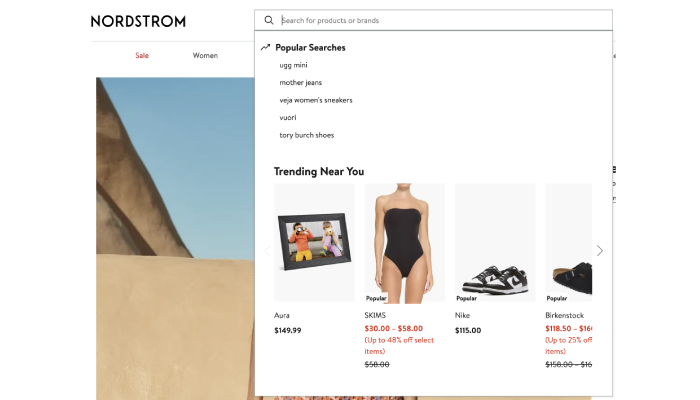

Shopping cart
The shopping cart is where customers keep their chosen products before finalizing their purchase. Your customers should be able to easily add items to their cart and remove them if they change their minds.
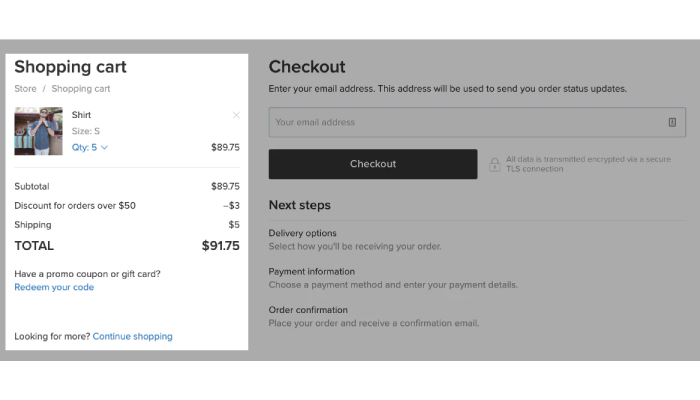

The checkout process should also be smooth and straightforward. A complicated or lengthy checkout can cause customers to abandon their carts.
Payment gateway
A secure and reliable payment gateway is the final step in the shopping journey, and if it’s not up to par, it can be a dealbreaker. You want your customers to feel completely confident when they enter their payment details. So, you want your website to integrate with trusted payment processors. If they sense anything sketchy, they’re likely to abandon their cart and take their business elsewhere.


You should also be able to support various payment options. This can include credit cards, PayPal, and other digital wallets. This allows your customers to choose the method they’re most comfortable with.


Shipping and delivery
Efficient shipping and delivery options keep customers happy and coming back for more. When customers can choose from multiple shipping options, it gives them the flexibility to select the method that best suits their needs, whether they’re looking for the fastest delivery or the most cost-effective choice. Clear pricing for these options is equally important, so there are no surprises at checkout—nobody likes hidden fees.


But it doesn’t stop there. Providing tracking information and regular delivery updates is just as important. When shoppers can easily see where their order is and know exactly when it will arrive, it gives them peace of mind and keeps them engaged with the process.
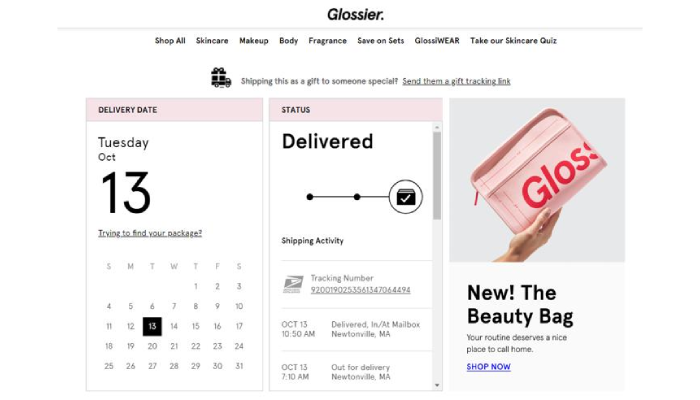

Why your business needs an ecommerce website
Whether you’re running a small boutique or a large corporation, an ecommerce site opens up a world of opportunities.
- 24/7 availability: Unlike a physical store, an ecommerce website never closes. Your customers can browse and shop at any time, even in the middle of the night. This means more potential sales without the need for extended hours or additional staff.
- Broader reach: With an ecommerce website, you’re not limited to a local customer base. You can reach people across the country—or even the world.
- Lower operating costs: Running an ecommerce site can be more cost-effective than maintaining a physical storefront. You can save on rent, utilities, and other overhead costs. Plus, automation tools can help manage operations like inventory and customer service, reducing the need for a large team.
- Data-driven decisions: You can track what products are selling, which marketing strategies are working, and where improvements can be made. This helps you make informed decisions to boost sales and customer satisfaction.
- Personalized shopping experience: An ecommerce website allows you to offer personalized recommendations, promotions, and content based on customer preferences and browsing history. This increases the likelihood of repeat business.
- Scalability: As your business grows, your ecommerce website can grow with you. Whether you’re adding new products, expanding into new markets, or increasing your marketing efforts, an ecommerce site provides the flexibility to scale up.
Choosing the best ecommerce website builder
When it comes to building your online store, choosing the right ecommerce website builder is crucial. The right platform can make all the difference in how your business operates and grows.
What to look for in an ecommerce website builder
Here are some essential features to consider when making your choice:
- Customization: Your e-commerce site should match your brand’s style. Choose a builder that lets you easily customize everything from the layout to the colors, so you can create a unique shopping experience that stands out.
- Scalability: As your business grows, your website should grow, too. Pick a builder that can handle more products, traffic, and features without slowing down.
- Ease of use: You don’t need to be a tech expert to build your site. Look for a builder with a user-friendly interface, drag-and-drop tools, and clear instructions so you can manage everything easily.
- Integration with payment gateways: Make sure your builder works seamlessly with popular payment gateways like PayPal, Stripe, or Square for secure and easy payments.
- SEO and marketing tools: To attract customers, your site needs to be easy to find online. Choose a builder that includes SEO tools, email marketing, and social media integration to help drive traffic and boost sales.
- Support and resources: Even with an easy-to-use platform, you might need help. Pick a builder that offers strong customer support and useful resources like tutorials and forums to guide you through any challenges.
Top ecommerce website builders
When it comes to the best ecommerce website builders, several top contenders stand out for their features, ease of use, and overall performance. Here are simple reviews of ecommerce website builders that stood out for us the past year:
- Dukaan
Dukaan stands out for its intuitive drag-and-drop builder and highly customizable themes, making it accessible for users without technical expertise. It offers a complete eCommerce solution with numerous plugins for marketing and conversion, all at an affordable price. - Wix
Wix is perfect for beginners, offering a user-friendly drag-and-drop builder and a wide variety of customizable templates. It’s best suited for small stores with limited products, though it may require third-party tools for more extensive inventory management. - Ecwid
Ideal for those on a budget, Ecwid allows you to start selling for free and integrates seamlessly with existing websites. It’s particularly useful for small stores or those adding eCommerce functionality to a non-eCommerce site. - BigCommerce
BigCommerce is a robust platform that powers major eCommerce brands. It offers extensive customization options and cross-channel commerce, though it comes with higher costs and revenue-based pricing tiers. - WooCommerce
WooCommerce is a top choice for WordPress users, providing extensive customization and integration options. It’s an open-source plugin, perfect for those with some technical skills looking for flexibility and control. - Shopify
Shopify is known for its extensive ecosystem of themes and tools, making it easy to scale your store. It’s ideal for large inventories but may require additional costs for third-party plugins and tools. - Squarespace
Squarespace offers beautiful, well-designed templates and a powerful drag-and-drop builder. It’s best for users who appreciate an all-in-one solution without the need for third-party apps, though it may be pricier for advanced features.
Free vs. paid options
Starting out, you might wonder whether to go for a free ecommerce website template or invest in a paid option. This depends on your business needs and budget. :
Free ecommerce website templates
Pros:
- Cost-effective: No upfront costs, making it ideal for those just starting out.
- Low risk: Allows you to experiment and test your online store without financial commitment.
Cons:
- Limited customization: Often comes with restrictions on design and functionality.
- Basic features: May lack advanced tools necessary for scaling your business.
- Upgrade necessity: As your business grows, you may need to switch to a paid option for more features.
Paid ecommerce website templates
Pros:
- Advanced features: Offers more tools and customization options to build a robust online store.
- Better design: Access to premium themes that provide a professional look.
- Enhanced support: Typically includes better customer service and technical support.
- Scalability: More storage and flexibility to grow your business.
Cons:
- Upfront cost: Requires an investment, which might be a drawback for those on a tight budget.
- Commitment: You’re financially committed, even if you’re unsure about long-term needs.
If you’re just starting and want to minimize costs, a free template might be enough. But if you’re planning for long-term growth, a paid plan could save you time and headaches down the line.
Building your ecommerce website
Building an ecommerce website might seem like a daunting task, but breaking it down into manageable steps makes the process much more approachable. Here’s a step-by-step guide to help you get started:
Select a platform
Choose an ecommerce platform that fits your business needs. The platform you choose will impact how you build, manage, and grow your store, so it’s important to pick the right one from the start.
Choose a domain name
Your domain name is your website’s address on the internet. It should be easy to remember, relevant to your brand, and ideally include keywords related to your business. Make sure it’s unique and reflects what your store is all about.
Set up hosting
Once you’ve secured a domain name, the next step is to choose a hosting provider. Hosting is where your website lives on the internet. Look for a reliable hosting service that offers good speed, security, and customer support. Some ecommerce platforms include hosting as part of their package, which can simplify this step.
Design your site
Start building your website by choosing a template or theme that aligns with your brand. Customize the layout, colors, fonts, and images to create a cohesive look that appeals to your target audience.
Add products
Upload your products to the site, including high-quality images, detailed descriptions, and accurate pricing. Organize them into categories to make it easy for customers to find what they’re looking for. If you’re still on the lookout for products to sell, here’s our in-depth guide on some of the best ecommerce products.
Set up payment and shipping
Integrate a payment gateway to process transactions securely. Also, configure your shipping options so customers can choose the best delivery method for their needs.
Test your site
Before going live, test your website thoroughly. Check for broken links, ensure the checkout process works smoothly, and make sure your site looks good on all devices.
Launch your site
Once you’re confident everything is in place, it’s time to launch! Announce your new website on social media, through email marketing, or with a special promotion to attract your first customers.
Using free ecommerce website templates
Free ecommerce website templates can be a great starting point, especially if you’re on a budget. However, to make your site truly unique, you’ll want to customize these templates to fit your brand.
Start by swapping out the default images and text with your own. Adjust the color scheme to match your brand colors, and tweak the fonts to reflect your brand’s personality.
Don’t forget to customize the layout to highlight your best-selling products or special promotions. Most templates offer drag-and-drop functionality, so you can easily rearrange elements to suit your needs.
E-commerce website examples
Looking at successful ecommerce websites can provide inspiration and insight into what works well.
WJD Exclusives


WJD Exclusives, a New York-based fine jewelry merchant, has built its brand on exceptional customer service. Founded in 2002, the company started with a simple website and a few product listings, but their commitment to customer satisfaction set them apart. By handling all aspects of their business in-house—from product listings and inventory management to customer repairs—they’ve been able to offer personalized, rapid services that keep customers coming back. Co-founder Vahan Avagyan attributes their success to this customer-first approach.
Two key tools have driven WJD Exclusives’ growth: WooCommerce and Afterpay. WooCommerce’s flexibility allows them to customize their website to meet customer needs, while Afterpay’s buy now, pay later option has significantly boosted sales and reduced returns. Avagyan estimates that over 30% of their traffic comes from the Afterpay Marketplace. For WJD Exclusives, prioritizing customer service is the foundation of their business, helping them turn first-time buyers into loyal customers who spread the word.
The Memo
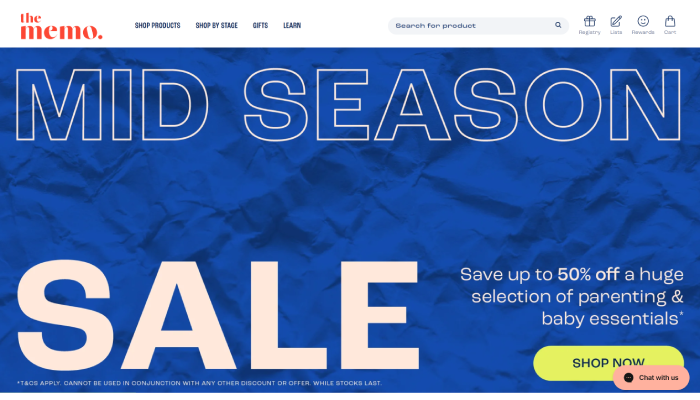

The Memo, founded in 2019, set out to make shopping for baby supplies easier and more supportive for parents. Co-founders Kate Casey and Phoebe Simmonds aimed to clear up the confusion in the baby retail space by creating a seamless and informative shopping experience. To achieve this, they needed an eCommerce solution that was easy to use and could unify their online and in-store touchpoints. With Shopify Plus and Shopify POS, The Memo has built a loyal customer base and seen remarkable growth, including a 45% YoY revenue increase and a 60% return customer rate.
The challenge for The Memo was ensuring that the in-store experience matched their high-quality online offering, especially since 70% of their in-store customers also shop online. Shopify’s native integration allowed The Memo to provide a consistent, simplified shopping journey across both platforms. This approach has helped The Memo create a unified experience that meets the needs of busy parents, whether they’re shopping online or in-store.
Using Shopify’s tools, The Memo has automated various processes, personalized customer interactions, and optimized their website for a seamless user experience. The result? Loyal customers who keep coming back and rapid business growth. With Shopify handling the technical side, The Memo can focus on what really matters—supporting parents on their journey.
Data insights: The state of ecommerce websites
Let’s dive into the latest data insights on e-commerce websites, covering key growth stats, emerging trends, and performance metrics that are shaping the online retail landscape.
Ecommerce growth statistics
Ecommerce is booming, and the numbers don’t lie. Over the past few years, ecommerce has seen tremendous growth globally and regionally. According to recent data, global ecommerce will surpass $6.3 trillion this year, marking a significant milestone in online retail. This growth isn’t slowing down anytime soon. Projections suggest that by 2026, global ecommerce sales could surpass $7 trillion, driven by increased internet access, mobile shopping, and changing consumer habits.
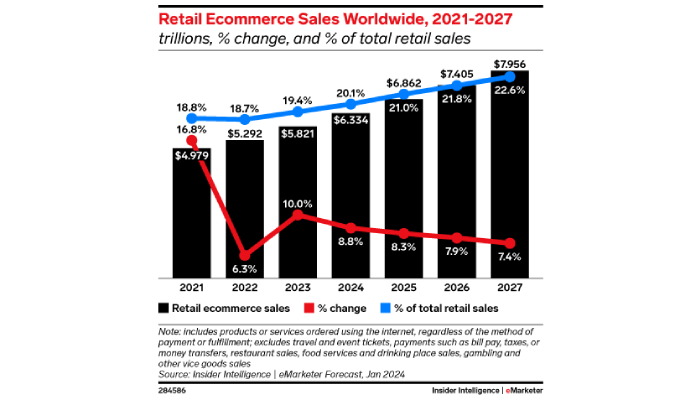

Regionally, Asia-Pacific continues to dominate the ecommerce landscape, accounting for the largest share of revenue. However, North America and Europe are also seeing robust growth, fueled by rising consumer confidence in online shopping and improved digital infrastructure.
As we look ahead, the next 5-10 years are expected to bring even more changes to the ecommerce space. Trends like the rise of social commerce, the expansion of AI and machine learning in personalizing shopping experiences, and the growing importance of sustainable and ethical shopping practices are set to shape the future of online retail.
Ecommerce website performance metrics
Understanding how your ecommerce website performs is crucial to its success. Key performance indicators (KPIs) like conversion rates, bounce rates, and average order value (AOV) provide insights into how well your site is meeting customer needs.
- Average conversion rates: Conversion rates can vary depending on the industry, but a typical ecommerce site sees an average conversion rate of 2-3%. However, top-performing sites often achieve rates above 5%.
- Bounce rates: The average bounce rate for ecommerce websites hovers around 45-50%. A high bounce rate may indicate that visitors aren’t finding what they’re looking for or are having trouble navigating the site.
- Other KPIs: Additional metrics like cart abandonment rates, customer lifetime value (CLV), and return on ad spend (ROAS) are also critical to monitor. These indicators help you understand customer behavior, measure marketing effectiveness, and identify areas for improvement.
Best-performing ecommerce platforms
When it comes to ecommerce platforms, some are leading the pack in terms of market share and performance. According to a 2023 report, WooCommerce is a frontrunner, with a market share of 39%. It’s especially popular among small to medium-sized businesses that value flexibility and control. Its offshoot, Woothemes, is second in place with a market share of 14.95%.
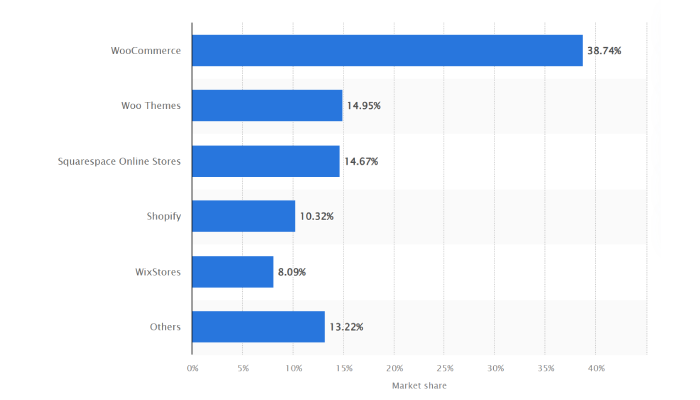

Squarespace, on the other hand, is third with a market share of 14.67%. In fourth place is Shopify, with a market share of 10.32%. Both of these platforms have user-friendly interfaces, extensive app ecosystems, and scalability, making them a popular choice for businesses of all sizes.
Customer behavior trends
Customer behavior in the ecommerce space is constantly evolving, influenced by technology, social trends, and economic factors. One of the most notable trends is the shift toward mobile shopping. Mobile devices now account for over 77% of global ecommerce traffic, highlighting the importance of mobile optimization for any online store.
- Mobile vs. desktop usage: While more people browse on their phones, they often switch to desktops for bigger or more complicated purchases, leading to higher conversion rates and order values on desktops.
- Average order values and purchasing behavior: Personalized shopping experiences, like subscription models, loyalty programs, and targeted promotions, are key to boosting average order values and encouraging repeat purchases.
- Sustainability and ethical shopping: Consumers are increasingly focused on sustainability. Brands that highlight eco-friendly products and ethical practices are gaining stronger customer loyalty and better conversion rates.
Optimizing your ecommerce website
Ecommerce website optimization attracts more visitors and ultimately drives sales. Here’s a breakdown of essential optimization strategies to help your online store perform at its best.
Ecommerce website optimization tips
The following are essential optimization strategies for a successful ecommerce website.
On-Page SEO
Optimizing your product pages, images, and content is crucial for improving your site’s visibility in search engines. Make sure to include relevant keywords in product titles, descriptions, and metadata. You can also optimize images by using alt tags.
Page speed optimization
Fast-loading pages are essential for keeping visitors engaged. A slow website can lead to higher bounce rates and lower conversions. To speed up your site, consider compressing images, enabling browser caching, and using a content delivery network (CDN). Regularly monitor your page speed and make adjustments as needed.
Mobile optimization
With more than half of ecommerce traffic coming from mobile devices, ensuring your site is mobile-friendly is non-negotiable. A responsive design that adapts to different screen sizes is a must. Simplify navigation for mobile users, ensure buttons and links are easily clickable, and make checkout processes as seamless as possible. Mobile optimization not only improves user experience but also positively impacts your search engine rankings.


Conversion rate optimization (CRO)
Increasing your website’s conversion rate is all about making it easier for visitors to become customers. Here are some techniques to boost sales and customer retention:
- Simplify the checkout process: A complicated or lengthy checkout can lead to cart abandonment. Streamline the process by reducing the number of steps, offering guest checkout options, and providing multiple payment methods.
- Use clear and compelling calls-to-action (CTAs): Encourage visitors to take action with prominent, well-worded CTAs. Whether it’s “Buy Now” or “Sign Up for Exclusive Offers,” make sure your CTAs stand out.
- Use social proof: Displaying customer reviews, testimonials, and ratings can build trust and encourage purchases. Highlight best-sellers and feature customer photos or user-generated content to enhance credibility.


Marketing and promotion
Once your site is optimized, the next step is to drive traffic and engage customers through effective ecommerce marketing strategies.
Search engine optimization (SEO)
Like other websites, ecommerce sites can benefit from SEO. This goes beyond on-page SEO.
Local and off-page SEO boosts your visibility. Start by identifying keywords your target audience is using, especially those related to your location if you have a physical presence.
For local SEO, optimize your site for location-based searches to attract nearby customers. This includes managing your Google My Business profile and ensuring your NAP (Name, Address, Phone number) is consistent across different directories.
Don’t forget off-page SEO. Build high-quality backlinks and work on improving your site’s domain authority to enhance your overall search engine ranking.
Content marketing
Adding a regular blog with valuable posts, optimizing product descriptions, and creating engaging social media content can drive traffic and boost your SEO efforts. Content marketing helps establish your brand as an authority and keeps customers coming back.
Email marketing
Building and maintaining an email list allows you to engage with customers directly. Create engaging email campaigns with personalized offers, product recommendations, and updates on new arrivals or promotions. Email marketing is one of the most effective ways to retain customers and encourage repeat purchases.
Social media marketing
Use platforms like Facebook, Instagram, and TikTok to promote your products and engage with your audience. Paid advertising on social media can help you reach a more extensive, targeted audience quickly. Create eye-catching posts and run campaigns that align with your overall marketing goals.
Ecommerce analytics and measurement
To understand how well your ecommerce website is performing, you need to track and analyze key metrics. Monitor metrics like:
- Website Traffic: The number of visitors coming to your website.
- Conversion Rates: The percentage of visitors who complete a desired action, like making a purchase.
- Average Order Value (AOV): The average amount of money spent each time a customer makes a purchase.
- Customer Acquisition Cost (CAC): The average cost of acquiring a new customer, including marketing and sales expenses.
These KPIs provide insights into how your site is performing and where improvements can be made.
Tools like Google Analytics are essential for tracking user behavior, understanding traffic sources, and measuring the effectiveness of your marketing campaigns. Use these insights to refine your strategies and make data-driven decisions.
Security and compliance
Protecting your customers’ data and ensuring your site complies with legal standards is crucial for building trust and maintaining a reputable online store.
Implement strong security measures to protect customer data, such as SSL certificates, encryption, and regular security audits. Make sure your site is safe from breaches and that customers feel confident when shopping with you.
Ensure your payment processes are secure and compliant with the Payment Card Industry Data Security Standard (PCI DSS). This not only protects sensitive information but also helps you avoid costly fines and damage to your reputation.
Lastly, stay informed about the legal requirements for ecommerce in your region. This includes privacy laws, tax regulations, and consumer protection guidelines. Complying with these laws helps avoid legal issues and builds customer trust.
Best practices for running your ecommerce website
Running a successful ecommerce website isn’t just about the initial setup—it requires ongoing effort to keep everything running smoothly and efficiently. Here are some best practices to ensure your online store stays in top shape.
Ongoing maintenance and updates
Regular maintenance is crucial to keeping your ecommerce website secure, updated, and functioning at its best.
- Security updates: Cybersecurity threats are constantly evolving, so it’s vital to keep your site’s software, plugins, and themes up to date. Regularly update your platform to patch vulnerabilities and protect customer data. Implement automated backups to ensure that your data is safe and can be restored quickly in case of an emergency.
- Content updates: Keep your site fresh by regularly updating content, including product descriptions, images, and blog posts. This not only improves SEO but also keeps your customers engaged and informed about new products or changes.
- Performance checks: Regularly monitor your site’s speed, functionality, and user experience. Slow load times or broken links can frustrate customers and lead to lost sales. Schedule regular checks to identify and fix any issues before they impact your business.
Analytics and performance tracking
As mentioned, Google Analytics is an essential tool for monitoring site performance. It provides valuable insights into user behavior, traffic sources, and conversion rates. By analyzing this data, you can identify what’s working and where there’s room for improvement.
Set up goals and track key metrics such as page views, bounce rates, and average session duration to gauge the effectiveness of your marketing efforts and overall site performance.
Customer service and support
Excellent customer service is the backbone of a successful ecommerce business. According to a Microsoft study, 96% of people said that customer service plays a big role in their brand loyalty and whether they’ll make repeat purchases. What’s more, 54% of respondents now see customer service as even more important than they did just a year ago.
Provide clear and accessible contact information, including phone numbers, email addresses, and live chat options. Being available and responsive to their needs shows that you care about their experience.
Effective customer support is also critical for resolving issues and retaining customers. Additionally, a well-defined returns and refunds policy can boost customer confidence and encourage purchases. Regularly gather customer feedback to identify areas for improvement and make adjustments as needed.


Final thoughts
Building and running a successful ecommerce website takes careful planning and continuous effort. Choosing the right ecommerce website builder is the foundation of your online store’s success. It’s essential to pick one that aligns with your business needs. From there, optimizing your website for performance, mobile use, and conversion rates will ensure that you’re providing the best possible experience for your customers.
Now that you’ve got a solid understanding of what it takes to create and manage an ecommerce website, it’s time to take the next step. Start by exploring the recommended ecommerce platforms we’ve discussed. If you need additional help, consider reaching out to their experts for guidance. The sooner you begin, the sooner you can start selling and growing your business online.
FAQs
What are ecommerce websites?
Ecommerce websites are online platforms that allow businesses to sell products or services over the internet. These sites provide everything a customer needs to browse, select, and purchase items from the comfort of their home or mobile device. Ecommerce websites typically include features like product catalogs, shopping carts, secure payment gateways, and customer service options to facilitate the entire shopping process.
What is the best ecommerce website builder to use?
The best ecommerce website for you depends on your specific needs and business goals. Some of our top picks include Dukaan, Wix, WooCommerce, and Shopify.
How do I start my own ecommerce website?
Starting your own ecommerce website involves several key steps:
- Pick an ecommerce platform that suits your business needs.
- Choose a domain name that reflects your brand.
- Select a hosting provider if your ecommerce platform doesn’t include hosting.
- Design your website by choosing and customizing a template or theme.
- Add your products, including images, descriptions, and pricing.
- Set up payment and shipping options to ensure smooth transactions.
- Test your website thoroughly before launching to catch any issues.
- Launch your site and start promoting it through marketing channels like social media, email, and SEO.
How much does an ecommerce website cost?
The cost of an ecommerce website can vary widely depending on several factors. Platform fees are a significant consideration. For instance, Shopify starts around $99 per month, while WooCommerce is free but requires hosting, which can range from $10 to $100 per month or more.
Design and development costs can vary, from using free templates to hiring a designer, which could add a few hundred to several thousand dollars, depending on the complexity. Paid plugins or apps may also increase costs over time. Remember to factor in ongoing expenses like domain renewal, marketing, and transaction fees. A basic ecommerce website might start at a few hundred dollars, while more advanced sites with custom features could cost several thousand dollars or more.















